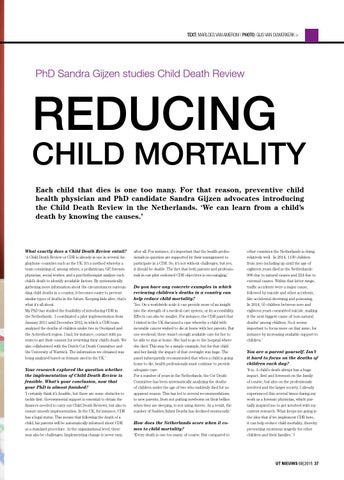TEXT: MARLOES VAN AMEROM | PHOTO: GIJS VAN OUWERKERK >
PhD Sandra Gijzen studies Child Death Review
REDUCING
CHILD MORTALITY Each child that dies is one too many. For that reason, preventive child health physician and PhD candidate Sandra Gijzen advocates introducing the Child Death Review in the Netherlands. ‘We can learn from a child’s death by knowing the causes.’
What exactly does a Child Death Review entail? ‘A Child Death Review or CDR is already in use in several Anglophone countries such as the UK. It’s a method whereby a team consisting of, among others, a pediatrician, GP, forensic physician, social worker, and a psychotherapist analyze each child’s death to identify avoidable factors. By systematically gathering more information about the circumstances surrounding child deaths in a country, it becomes easier to prevent similar types of deaths in the future. Keeping kids alive, that’s what it’s all about. My PhD has studied the feasibility of introducing CDR in the Netherlands. I coordinated a pilot implementation from January 2011 until December 2012, in which a CDR team analyzed the deaths of children under two in Overijssel and the Achterhoek region. I had, for instance, contact with parents to get their consent for reviewing their child’s death. We also collaborated with the Dutch Cot Death Committee and the University of Warwick. The information we obtained was being analyzed based on formats used in the UK.’
Your research explored the question whether the implementation of Child Death Review is feasible. What’s your conclusion, now that your PhD is almost finished? ‘I certainly think it’s feasible, but there are some obstacles to tackle first. Governmental support is essential to obtain the finances needed to carry out Child Death Reviews, but also to ensure smooth implementation. In the UK, for instance, CDR has a legal status. This means that following the death of a child, his parents will be automatically informed about CDR as a standard procedure. At the organizational level, there may also be challenges. Implementing change is never easy,
after all. For instance, it’s important that the health professionals in question are supported by their management to participate in a CDR. So, it’s not without challenges, but yes, it should be doable. The fact that both parents and professionals in our pilot endorsed CDR objectives is encouraging.’
Do you have any concrete examples in which reviewing children’s deaths in a country can help reduce child mortality? ‘Yes. On a worldwide scale it can provide more of an insight into the strength of a medical care system, or its accessibility. Effects can also be smaller. For instance, the CDR panel that I visited in the UK discussed a case whereby a child with incurable cancer wished to die at home with her parents. But one weekend, there wasn’t enough available care for her to be able to stay at home. She had to go to the hospital where she died. This may be a simple example, but for that child and her family the impact of that oversight was huge. The panel subsequently recommended that when a child is going home to die, health professionals must continue to provide adequate care. For a number of years in the Netherlands, the Cot Death Committee has been systematically analyzing the deaths of children under the age of two who suddenly died for no apparent reason. This has led to several recommendations to new parents, from not putting newborns on their bellies when they are sleeping, to not using duvets. As a result, the number of Sudden Infant Deaths has declined enormously.’
How does the Netherlands score when it comes to child mortality? ‘Every death is one too many, of course. But compared to
other countries the Netherlands is doing relatively well. In 2014, 1130 children from zero including up until the age of eighteen years died in the Netherlands: 906 due to natural causes and 224 due to external causes. Within that latter range, traffic accidents were a major cause, followed by suicide and other accidents, like accidental drowning and poisoning. In 2014, 55 children between zero and eighteen years committed suicide, making it the next biggest cause of ‘non-natural deaths’ among children. So it seems important to focus more on that issue, for instance by increasing available support to children.’
You are a parent yourself. Isn’t it hard to focus on the deaths of children each day? ‘It is. A child’s death always has a huge impact, first and foremost on the family of course, but also on the professionals involved and the larger society. I already experienced this several times during my work as a forensic physician, which partially inspired me to get involved with my current research. What keeps me going is the idea that if we implement CDR here, it can help reduce child mortality, thereby preventing enormous tragedy for other children and their families.’ |
UT NIEUWS 08|2015 37
